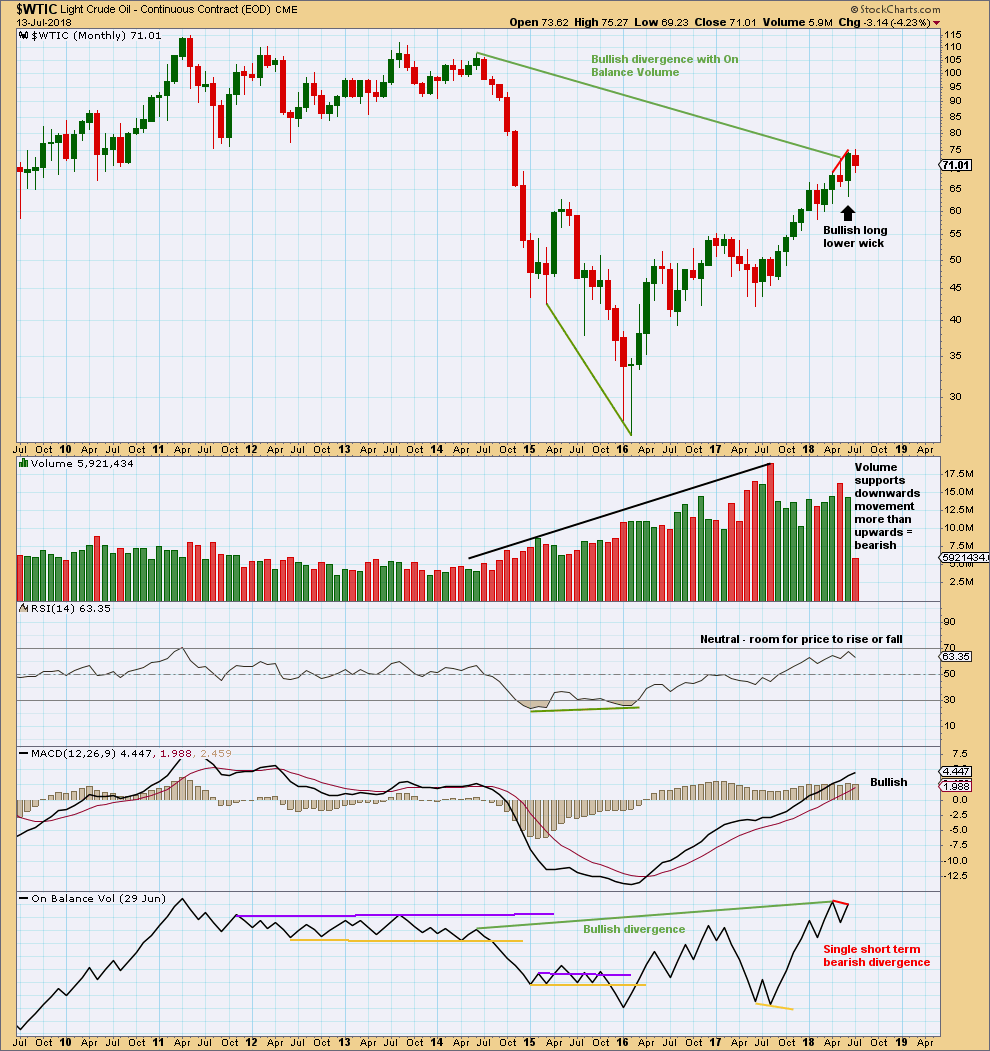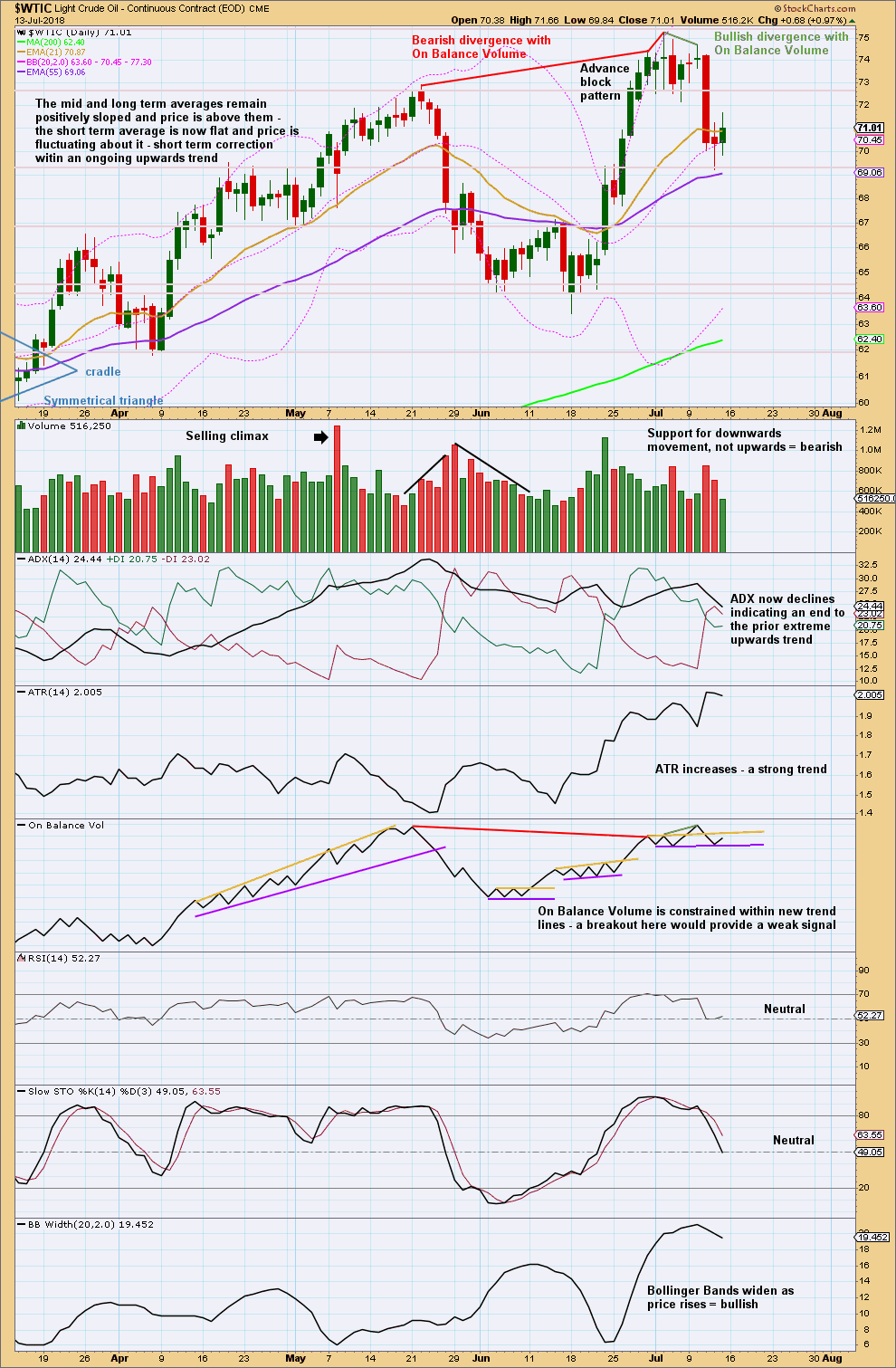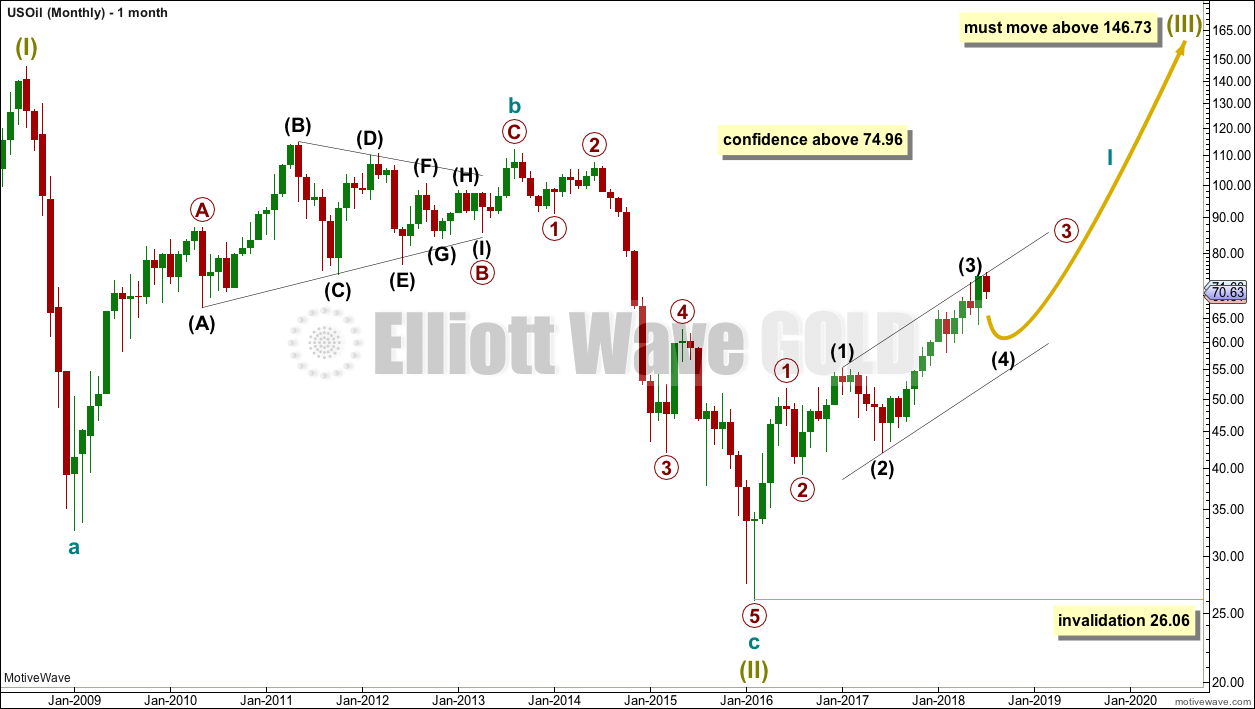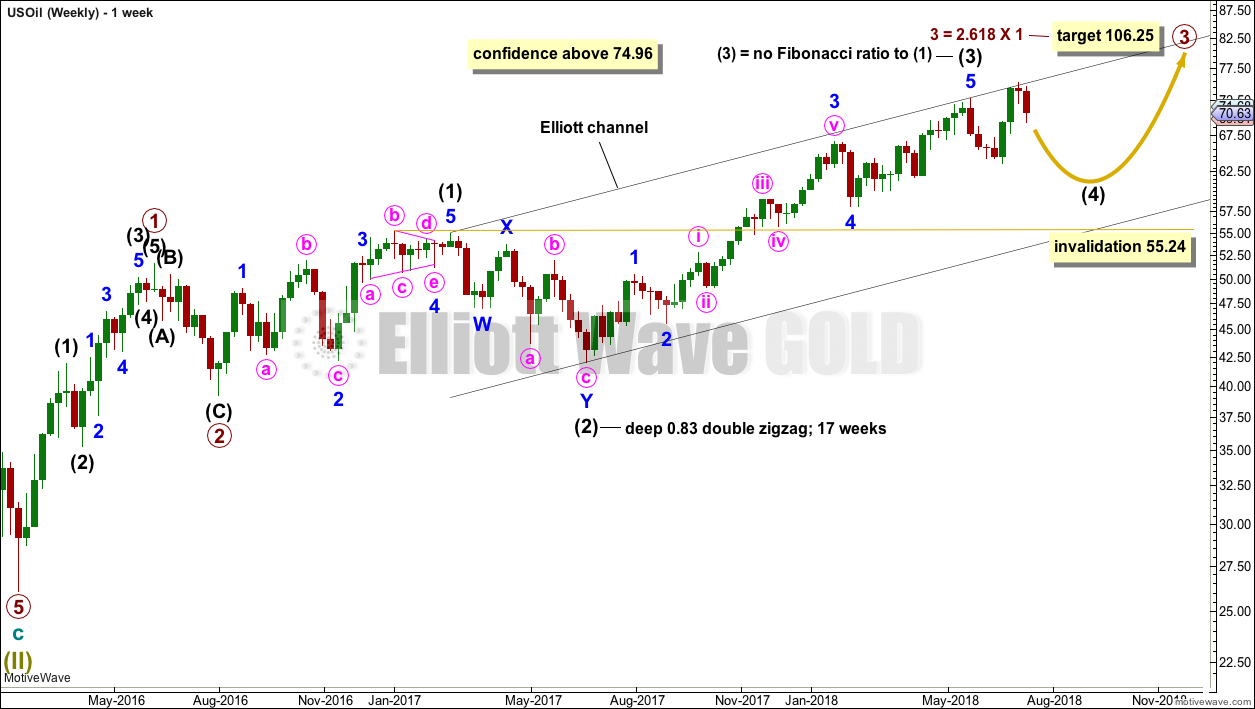Downwards movement was expected for the week for US Oil, and this is exactly what has happened.
Summary: This downwards swing may now continue to about 61.22.
A deeper and longer lasting consolidation may be underway, which may last about 13 to 21 weeks in total. It should remain above 55.24, and the target is about 61.12. The consolidation will not move in a straight line; it may swing from resistance to support and back again in large swings. Once resistance and support are identified, then a swing trading system may be employed by more experienced traders. Support may now be about 63.0 and resistance may be about 75.25.
Always practice good risk management as the most important aspect of trading. Always trade with stops and invest only 1-5% of equity on any one trade. Failure to manage risk is the most common mistake new traders make.
New updates to this analysis are in bold.
MAIN WAVE COUNT
MONTHLY CHART
It is possible that the bear market for Oil is over and a new bull market is in the very early stages.
A huge zigzag down to the last low may be complete and is labelled here Super Cycle wave (II).
Cycle wave b must be seen as complete in August 2013 for this wave count to work. It cannot be seen as complete at the prior major swing high in May 2011.
Cycle wave b is seen as a zigzag, and within it primary wave B is seen as a running contracting triangle. These are fairly common structures, although nine wave triangles are uncommon. All subdivisions fit.
Primary wave C moves beyond the end of primary wave A, so it avoids a truncation. But it does not have to move above the price territory of primary wave B to avoid a truncation, which is an important distinction.
If cycle wave b begins there, then cycle wave c may be seen as a complete five wave impulse.
Super Cycle wave (III) must move beyond the end of Super Cycle wave (I). It must move far enough above that point to allow room for a subsequent Super Cycle wave (IV) to unfold and remain above Super Cycle wave (I) price territory.
Cycle wave I may be incomplete. It may be unfolding as an impulse and may have now moved through the middle portion. Commodities have a tendency to exhibit swift strong fifth waves, and this tendency is especially prevalent for third wave impulses. Intermediate wave (5) to end primary wave 3 may be very swift and strong, ending with a blow off top.
When cycle wave I is complete, then cycle wave II may be a deep correction that may not move beyond the start of cycle wave I below 26.06.
Data from FXCM for USOil does not go back to the beginning of Super Cycle wave (I). Without an accurate known length of Super Cycle wave (I) a target cannot be calculated for Super Cycle wave (III) to end using Fibonacci ratios. The target for Super Cycle wave (III) may be calculated when cycle waves I, II, III and IV within it are complete. That cannot be done for many years.
WEEKLY CHART
Intermediate wave (3) may now be complete. There is no Fibonacci ratio between intermediate waves (1) and (3), and intermediate wave (3) is longer than 1.618 the length of intermediate wave (1).
This wave count fits with classic technical analysis at the monthly and daily chart levels.
Intermediate wave (2) was a deep double zigzag. Given the guideline of alternation, intermediate wave (4) may be expected to most likely be a shallow flat, triangle or combination. It may be about even in duration with intermediate wave (2), or it may be a little longer because triangles and combinations are more time consuming structures.
In the first instance, a Fibonacci 13 weeks may be expected for intermediate wave (4). If about that time the structure is incomplete, then the next Fibonacci number in the sequence at 21 will be expected. At this stage, it has lasted only 7 weeks.
Intermediate wave (4) may find support about the lower edge of the black Elliott channel. It may end within the price territory of the fourth wave of one lesser degree; minor wave 4 has its territory from 66.65 to 59.13.
DAILY CHART
If intermediate wave (4) unfolds as a double combination, flat or triangle, then the first wave down within it would be a three wave structure and most likely a zigzag.
All of a flat, combination or triangle may have within them a new high above the start of intermediate wave (4) at 72.90 as in an expanded flat, running triangle or wave X of a double combination. There can be no upper invalidation point for this reason.
It is impossible at this stage to tell which of several possible structures intermediate wave (4) may be, only that it is least likely to be a single or multiple zigzag. Focus will be on identifying when intermediate wave (4) may be over.
The zigzag down may be minor wave A within a flat or triangle for intermediate wave (4), or it may be a zigzag within a double combination for intermediate wave (4).
The movement labelled minor wave B or X looks like an expanded flat correction. Minute wave c now fits as a completed five wave impulse. Minor wave B or X is a 1.27 length of minor wave A or W. This is within the common range of 1 to 1.38 for wave B of a flat correction.
If intermediate wave (4) is unfolding as a flat correction, then within it minor wave B has now met the minimum 0.9 length of minor wave A. With minor wave B a 1.27 length of minor wave A, intermediate wave (4) may be unfolding as an expanded flat correction, which is the most common type. Minor wave C of a flat correction must unfold as a five wave structure.
If intermediate wave (4) is unfolding as a triangle, then there is no minimum requirement for minor wave B within it. With minor wave B ending beyond the start of minor wave A, intermediate wave (4) may be a running triangle. Minor wave C of a triangle must unfold as a single or double zigzag.
If intermediate wave (4) is unfolding as a combination, then there is no minimum nor maximum length required for minor wave X. Minor wave Y of a combination may unfold as a flat or triangle.
Intermediate wave (4) may not move into intermediate wave (1) price territory below 55.24.
ALTERNATE DAILY CHART
This alternate wave count is identical to the first daily chart above except for the degree of labelling within intermediate wave (4) which is moved down one degree.
Intermediate wave (4) may be unfolding as a double combination, with the first structure in a double an expanded flat correction labelled minor wave W. Double combinations are very common structures.
The short term expectation for some downwards movement about here is exactly the same for both wave counts. If minute wave b moves higher, then it would most likely end at or before 75.68. At the last high, minute wave b is a 1.27 length to minute wave a; this is within the normal range.
TECHNICAL ANALYSIS
MONTHLY CHART

Click chart to enlarge. Chart courtesy of StockCharts.com.
The short term volume profile is bearish: the strongest month in the last few months was the downwards month of May (where the balance of volume was down) and now June shows a decline in volume, so volume has not supported upwards movement here.
For the short term, On Balance Volume is also slightly bearish. This supports the idea that price may be within a correction and not necessarily a continuation of the larger upwards trend.
However, it is entirely possible that this situation could reverse and volume could start to support upwards movement, as has happened back in January 2018.
The larger trend is upwards.
DAILY CHART

Click chart to enlarge. Chart courtesy of StockCharts.com.
ADX now indicates no clear trend; the market may be consolidating.
Expect swings from support to resistance and back again, using Stochastics to indicate when each swing may end. With Stochastics reaching overbought at the last highs, resistance may now be about 75.25 and support may be about 63.40. Expect a downwards swing here to support, which may end when price finds support and Stochastics reaches oversold.
Published @ 06:36 p.m. EST on 14th July, 2018.





Updated daily chart for US Oil:
There is now a nice clear five down. Look now for a bounce, a three up.
I’ll label the five down minute i, and the three up minute ii. Targets for minute ii are the 0.382 and 0.618 Fibonacci ratios, favouring neither in this case. Look for the 0.382 first, and if price gets there and it looks like a three on the daily chart it could be over. But if price gets there and it doesn’t look like a three, then look for more upwards movement to the 0.618.
When this bounce is done we may then expect another wave down to move well below mintue i.
If any of this does not make sense, please ask questions here in comments. I’ll be checking daily and will reply.
Thanks for the update Lara!